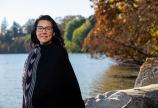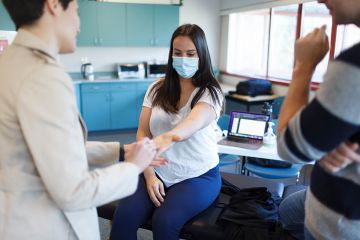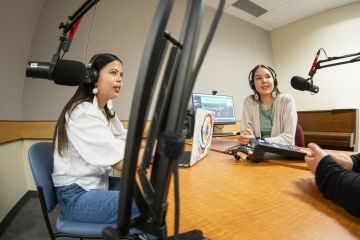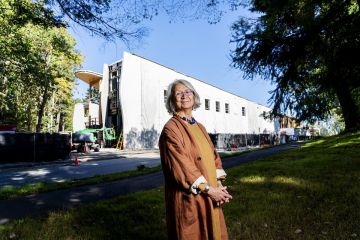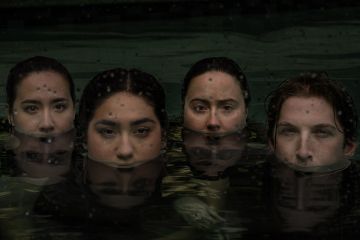Supporting Indigenous language revitalization efforts across Canada
- Tara Sharpe
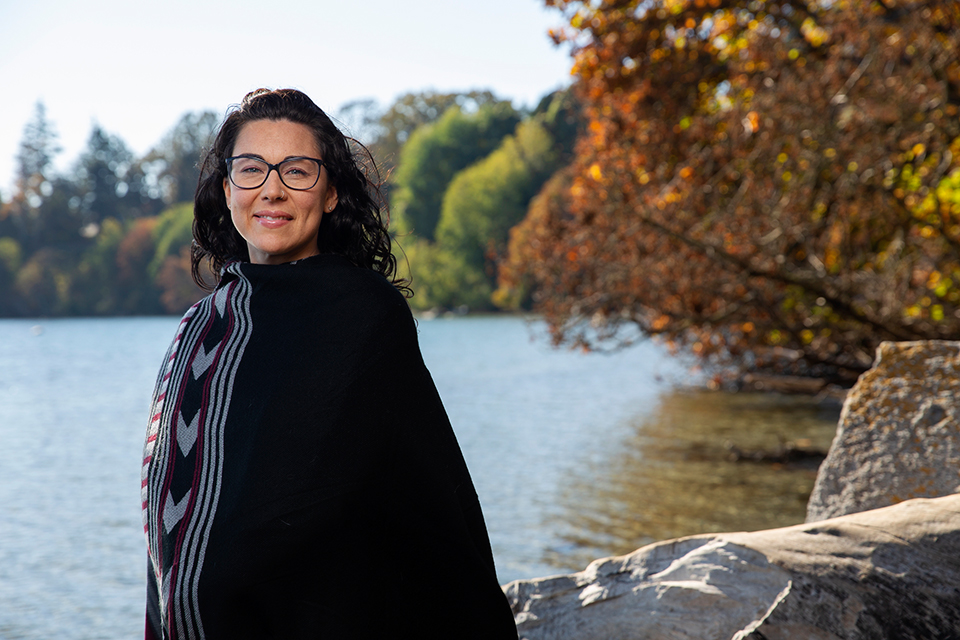
ÁSW̱. ЌENI. ЌL̵O,EL. Seal, seagull, camas—this is the English translation for these three words in SENĆOŦEN, the language of the WSÁNEĆ peoples whose traditional territory includes what’s now known as the Saanich Peninsula. SENĆOŦEN and Lkwungen, which is the language of the Songhees and Esquimalt peoples, have been spoken here long before the first Norse seafarers arrived on the east coast.
A new guide by UVic researcher Onowa McIvor invites everyone to embark on an Indigenous language learning journey. “The most powerful act of reconciliation that anybody could do in terms of Indigenous languages is to learn the Indigenous language of the land they are on,” says McIvor, whose maternal family is maskēkowak (Swampy Cree) from Northern Manitoba (Norway House and Cross Lake Cree Nations), with Scottish-Canadian settler ancestry on her paternal side.
“The essence of our work is supporting Indigenous communities who are working really hard to reclaim, revive and maintain their languages,” adds McIvor. “But there’s also a part of our project that is about raising the profile of Indigenous languages for all Canadians. That’s what this new guide is all about.”
Supporting the revitalization of Indigenous languages
McIvor compiled the guide, together with UVic MA graduate Nicole Davies, for the Canadian Commission on UNESCO. Launched last month on the 11th anniversary of the signing of the United Nations Declaration on the Rights of Indigenous Peoples, it outlines how anyone can support Indigenous languages in their community.
McIvor points to the vital need for language learners to hear the words spoken. “These languages hold different sounds than English. You’ll hear people say, ‘WAH-SAH-NICK’ [rather than ‘WHA-SAH-NICH’ for WSÁNEĆ] because they’re reading it in English. When using Roman orthography—the alphabet we know as A, B, C—people try to pronounce it in English.”
The area now called British Columbia is less than 10 per cent of the total land mass of Canada, yet is home to approximately 60 per cent of all Indigenous languages in this country.
McIvor says with Indigenous language revitalization, we have to start somewhere. One way can be with landmarks. “You can learn how to say the name of the territory or the name of the mountain that is close by,” suggests McIvor.
For example, the original name for Mount Newton is LÁU,WELNEW—the high point of refuge for the WSÁNEĆ peoples during the time of the “great flood.”
“If you learn a greeting and a response, now you’ve had a conversation,” adds McIvor. “And that’s the start of something, isn’t it?”
NEȾOLṈEW̱, doing things as one
NEȾOLṈEW̱ is another SENĆOŦEN word. It translates as “one mind, one people” or “doing things as one” and is the name of the six-year $2.5M research project being led by McIvor with Sḵwx̱wú7mesh First Nation linguist Peter Jacobs who joined UVic in 2012 and is now at SFU. It is the first national project of its kind in Canada focused on Indigenous language revitalization.
McIvor and Jacobs are collaborating with nine Indigenous-led partner organizations to further strengthen the revitalization of Indigenous languages across Canada.
In an earlier project, they conducted the first-ever study of a popular adult language learning method. The focus on adult language learners is a unique and ongoing feature of the NEȾOLṈEW̱ project.
Following a path of language learning
McIvor was Director of UVic Indigenous Education from 2008 to 2017 and, as a graduate student at UVic, served as the liaison for First Nations communities partnered with UVic’s School of Child and Youth Care from 2000 to 2004 to deliver a two-year diploma program in early childhood care and development.
Throughout her academic career, McIvor has studied and helped develop best practices for revitalizing Indigenous languages; explored the influences and learnings woven into Indigenous languages and passed on generationally; and worked to understand and enhance contributions by Indigenous adults to language revitalization, as well as its links to health and well-being of Indigenous communities and families.
NILLA, a new online space
NILLA is an exciting new online web sharing portal and part of the NEȾOLṈEW̱ project. “It is a place where Indigenous communities can connect with one another, and all Canadians can learn more about Indigenous languages and their continuation” adds McIvor.
The NEȾOLṈEW̱ project is funded by the Social Sciences and Humanities Research Council.
More on Indigenous language revitalization at UVic
EdgeWise: learn more
- The University of Victoria stands on the traditional territory of the Lkwungen-speaking peoples.
- Nine of the Truth and Reconciliation Commission of Canada’s 94 Calls to Action pertain directly to language revitalization.
- Two of 12 recommendations in the UNESCO guide are: “incorporate Indigenous place names and greetings on posters and signs at your workplace” and “mobilize interest in the works of Indigenous language musicians, artists and filmmakers.” (PDF)
- The first-ever translation of the Douglas Treaties into SENĆOŦEN and Lkwungen was a pivotal element in an event organized by Songhees First Nation and UVic in 2017. The translations are now kept at the Royal BC Museum alongside the English versions. Read the story.
- The First Peoples’ Cultural Council (FPCC)—formed in 1990 on W̱SÁNEĆ traditional territory—produces reports outlining the challenges and successes of revitalizing Indigenous languages. The FPCC also administers programs such as the Endangered Languages Project (an online resource) and FirstVoices (an archive and teaching resource including dictionaries, alphabets, audio and video). Visit firstvoices.com for audio clips with correct pronunciations of many Indigenous words.
- From language revitalization to Indigenous law, UVic researchers are working with Indigenous communities and organizations in Canada and around the world to understand, preserve and celebrate Indigenous traditions and cultures. Find out more about Indigenous focus at UVic.
Photos
In this story
Keywords: Indigenous, Indigenous languages, languages and linguistics, Indigenous education, research
People: Onowa McIvor
Publication: knowlEDGE

